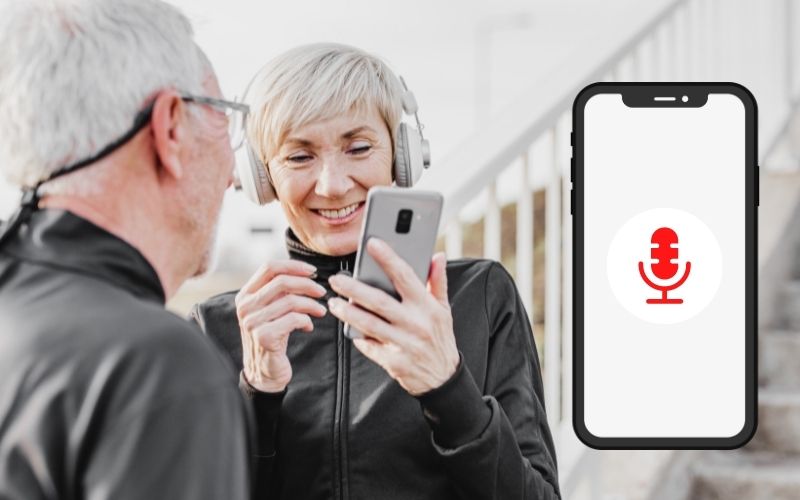Voice-activated phones are a transformative technology for blind and senior individuals, offering a new level of independence and connectivity. These specialized phones are designed to respond to vocal commands, allowing users to make calls, receive calls, and manage other functions without the need to see or physically interact with the device. For the visually impaired, this technology eliminates the challenge of navigating small buttons or touchscreens. For seniors, especially those with limited mobility or dexterity issues, voice-activated phones can be a lifeline, enabling easy communication with family, healthcare providers, and emergency services. Overall, these phones are empowering tools that enhance safety, accessibility, and quality of life for some of the most vulnerable populations.
Benefits of Voice-Activated Phones for Seniors
- Hands-Free Operation: Enables seniors to make calls and send messages without needing to press buttons.
- Enhanced Safety: Quick and easy voice commands for emergency calls.
- Ease of Use: Simplifies the user interface, reducing the learning curve for technology.
- Accessibility: Ideal for those with vision, mobility, or dexterity issues.
- Independence: Empowers seniors to communicate without assistance from others.
- Reduced Strain: Eliminates the need to squint at small text or press small buttons.
- Convenience: Allows seniors to easily set reminders, ask questions, and access information.
- Social Connection: Facilitates easy communication with family and friends.
- Health Monitoring: Can integrate with health apps for reminders and tracking.
- Entertainment: Easy voice commands to access music, audiobooks, and radio.
The 8 Best Voice Activated Phones for the Blind & Senior Individuals

1. SmartVision 3
The SmartVision 3 is a versatile Android smartphone tailored for the blind or visually impaired. It seamlessly integrates tactile, voice, and touchscreen controls, ensuring an accessible experience for its users.
Key Features
- Tactile Keypad: Navigate and interact using large, tactile buttons.
- Voice Control: Dedicated button for instant access to Google Assistant.
- Touchscreen Gestures: Full control with TalkBack gestures.
- NFC Tags: Recognize objects or perform actions with included NFC tags.
- Vision Tools: Pre-installed apps like banknote recognizer, color detector, and more.
- Wireless Charging: Available in the SmartVision 3 Premium variant.
- SOS Feature: Emergency alerts to predefined numbers.
Specifications
- Dimensions: 159 x 68 x 10.4 mm
- Weight: 160 g
- Display: 3.5″, 640 x 960 pixels
- Memory: RAM 4GB, ROM 64GB
- Processor: Octa-core MEDIATEK MT6771T (P70)
- Battery: 3500 mAh Li-ion
- Cameras: Rear 16MP + 2MP, Front 5MP
Pros
- Multiple control options catering to varied needs.
- Access to Google Play for a wide app selection.
- Specialized tools for the visually impaired.
Cons
- Slightly bulkier due to the tactile keypad.
- Premium price point for its specifications.
2. MINIVISION2+ CELL PHONE
The MINIVISION2+ Cell Phone is a big-button cell phone designed for individuals who are blind or visually impaired. It offers a blend of traditional tactile controls with modern smartphone features, ensuring ease of use and accessibility.
Key Features
- Tactile Keypad: Large, easy-to-identify buttons for navigation and interaction.
- Voice Guide: Speaks everything on the screen, providing complete accessibility.
- Voice Commands: Allows users to place calls, send texts, and more using voice.
- SOS Button: A dedicated button on the back for emergency alerts.
- Speed Dial: Enables calls with a single button press.
- Vision Tools: Includes features like color identifier, money identifier, and a “Where am I?” function.
- Camera and Photo Album: Allows users to capture and view photos.
Specifications
- Dimensions: 125 x 60 x 13.5 mm
- Weight: 103 g
- Display: 2.3″ QVGA (240 x 320 pixels)
- Processor: Dual Core Cortex-A7
- Memory: RAM 1 GB, Flash 8 GB
- External Memory: Supports SD card, up to 32GB
- Cellular Connectivity: 4G VoLTE / 3G / 2G
- Battery: 1600 mAh Li-ion (200 hours standby, 7 hours talk time)
- Camera: 2 MPixels
- Color: White with black keypad
Pros
- User-friendly design with tactile buttons.
- Comprehensive voice guide for full accessibility.
- Emergency SOS button for safety.
Cons
- Limited to GSM networks.
- Might be considered basic compared to mainstream smartphones.
3. LIVELY Jitterbug Flip2
The Lively Jitterbug Flip2 is a user-friendly flip phone designed with seniors in mind. Manufactured by GreatCall, it focuses on simplicity, safety, and accessibility, making it an ideal choice for those who prefer a straightforward communication device without the complexities of modern smartphones.
Key Features
- Big Buttons: Large, tactile buttons for easy dialing and navigation.
- Powerful Speaker: Ensures clear conversations even in noisy environments.
- Urgent Response Button: A dedicated button to connect users to emergency services.
- Voice Dial: Allows users to make calls using voice commands.
- Magnifier with Flashlight: Helps in reading small print.
- Camera: For capturing photos.
Specifications
- Display: Typically around 3.2 inches (please verify on the product page)
- Camera: Basic camera, often around 2 MP
- Battery Life: Varies, but flip phones like this often have several days of standby time.
- Storage: Limited, mainly for contacts and a few photos.
- Connectivity: Basic cellular connectivity, often 4G LTE.
Pros
- Simple and easy-to-use interface.
- Dedicated emergency button for safety.
- Voice dialing feature for hands-free calling.
Cons
- Lacks advanced features of modern smartphones.
- Limited storage and camera capabilities.
4. Google Pixel
The Google Pixel is renowned for its integration of advanced Android features and accessibility tools. Tailored for a broad audience, including those who are blind or visually impaired, the Pixel offers a seamless user experience backed by Google’s robust ecosystem.
Key Features
- Google Assistant: A dedicated button provides easy access, allowing users to control many features by voice, such as placing calls, sending texts, setting alarms, and more.
- Voice Typing: Users can dictate text into any text field of an app, enhancing the messaging experience.
- Built-in Screen Reader: The phone uses TalkBack, Google’s built-in screen reader, offering a comprehensive navigation experience.
- Google’s Accessibility Apps: The Pixel is compatible with Google’s suite of accessibility apps, including Lookout and Reader, designed to assist visually impaired users.
Specifications
- Display: Varies depending on the specific Pixel model, but typically OLED with high resolution.
- Processor: High-end Qualcomm Snapdragon (specific model varies).
- Memory: RAM and storage configurations vary based on the model.
- Camera: Advanced camera system with features like Night Sight and Super Res Zoom.
- Battery Life: All-day battery life with fast charging capabilities.
- Connectivity: 4G LTE and 5G options, Wi-Fi, NFC, and Bluetooth.
- Operating System: Latest Android version with guaranteed updates.
Pros
- Seamless integration of Google services and apps.
- Regular software updates ensuring the latest features and security.
- High-quality camera system.
- Comprehensive accessibility features tailored for the visually impaired.
Cons
- Might be pricier than some other options in the market.
- No expandable storage option.
5. iPhone
The iPhone, developed by Apple, is not just a premium smartphone but also a device that has been meticulously designed with accessibility in mind. Apple’s commitment to inclusivity is evident in the range of features it offers to cater to the visually impaired, ensuring that they can fully utilize the device’s capabilities.
Key Features
- VoiceOver: Apple’s built-in screen reader that provides auditory descriptions of on-screen elements, enabling navigation by listening and performing gestures.
- Typing Feedback: As you type, the device speaks letters, words, auto-corrections, and capitalizations. Touching and holding a word also provides text predictions.
- Audio Descriptions: While watching videos or movies, users can turn on audio descriptions to have scenes described to them.
- Magnifier: Transforms the iPhone into a magnifying glass, allowing users to zoom in on objects. It also offers the ability to apply color filters to enhance visibility.
- Display and Text Size Adjustments: Users can modify display features, such as Invert Colors, adjust font size, color intensity, and tint to enhance readability.
- Zoom: Offers the ability to magnify the screen, either in full or through a resizable lens.
- Reduce Motion: For those sensitive to motion effects or screen movement, this feature can be used to minimize these effects.
Specifications
- Display: Retina display with varying sizes depending on the model.
- Processor: Apple’s A-series chip (specific model varies).
- Memory: RAM and storage configurations vary based on the model.
- Camera: Advanced camera system with features like Night mode, Deep Fusion, and Smart HDR.
- Battery Life: All-day battery life with fast charging capabilities.
- Connectivity: 4G LTE, 5G (in newer models), Wi-Fi 6, NFC, and Bluetooth.
- Operating System: iOS with regular updates.
Pros
- Comprehensive suite of accessibility features tailored for the visually impaired.
- Seamless integration with other Apple devices and services.
- Regular software updates ensuring the latest features and security.
- High-quality build and performance.
Cons
- Generally more expensive than many other smartphones in the market.
- No expandable storage option.
6. Moto G7
The Moto G7 is a versatile smartphone that offers a blend of advanced features and user-friendly functionalities. Recognized for its voice command capabilities, the Moto G7 is particularly suitable for visually impaired individuals, providing them with an enhanced and accessible mobile experience.
Key Features
- Built-in Alexa Voice Commands: Operate a majority of the phone’s features without pressing a button.
- Large, High-Definition Screen: Offers a clear and vibrant display, making it easier for reading and viewing media.
- Access to Android App Store: Users can download a variety of apps tailored for their needs.
- Motorola-exclusive Shortcuts: Quick access to important features and apps with ease.
- Customization Features: Adjust text size and color to improve readability.
Specifications
- Display: Large, 6.2-inch screen.
- Processor: Qualcomm Snapdragon (specific model varies).
- Memory: RAM and storage configurations vary based on the model.
- Camera: Advanced camera system with features like portrait mode and night vision.
- Battery Life: Impressive battery life, lasting more than a day on a single charge. Rapid charging capabilities.
- Connectivity: 4G LTE, Wi-Fi, NFC, and Bluetooth.
- Operating System: Android with regular updates.
Pros
- Voice commands powered by Alexa, enhancing hands-free operations.
- Large screen size for better visibility.
- Customization options to cater to visually impaired users.
- Affordable price point compared to other smartphones with similar features.
Cons
- Might have a steeper learning curve for those unfamiliar with smartphones.
- Not the latest in the Moto series, so might lack some newer features.
7. ATS Totally Voice Activated Telephone
The ATS Totally Voice Activated Telephone is a revolutionary device designed to provide complete hands-free operation. This phone is specifically tailored for those who may have difficulty using their hands or are visually impaired, ensuring they can communicate effortlessly.
Key Features
- Totally Hands-Free: Users can dial, answer, and end calls purely through voice commands.
- Voice Dialing: Store up to 17 frequently called numbers and dial them by simply saying their name.
- Talking Caller ID: The phone announces the caller’s number, enhancing accessibility.
- 80 Incoming CID: Store and review the last 80 numbers that called you.
- LCD Display: A 2-line display that shows 16 characters per line, providing clear information.
- Hands-Free Speakerphone: High-quality loudspeaker for clear conversations.
- Vocal Prompts: Guided prompts that can be toggled on or off based on user preference.
- Memory Backup: Ensures that your settings are preserved, even after power interruptions.
Specifications
- Display: 2-line LCD with 16 characters per line.
- Voice Memories: Store up to 17 voice-activated numbers.
- Incoming CID: Store and review the last 80 incoming call numbers.
- Power: 110v – 220v AC Power Supply (with worldwide compatibility using a plug adapter).
- Handset Volume: Adjustable up to 40db.
- Visual Ring Indicator: LED indicator to visually signal incoming calls.
- Ringer Volume: Adjustable with off/low/high switch.
Pros
- Complete voice-activated functionality, eliminating the need for manual operation.
- Vocal prompts guide users through various functions.
- Memory backup ensures saved settings are retained.
- Suitable for international use with its versatile power supply.
Cons
- Limited to the features mentioned, may not have advanced smartphone capabilities.
- Might have a learning curve for users unfamiliar with voice-activated systems.
8. Motorola Moto G6
The Motorola Moto G6 is a mid-range smartphone that is designed to be budget-friendly while offering a range of features that make it a great choice for seniors and visually impaired individuals. With its integration of Google Assistant, Speech Recognition, and other accessibility features, it aims to provide a seamless and efficient user experience.
Key Features
- Google Assistant App: Enables voice commands for various phone functions.
- Speech Recognition: Allows hands-free control of the phone.
- Magnifying Glass Feature: Assists in reading by magnifying text and images.
- Full Voice Control Dedicated Keys: Enables complete voice-activated navigation and control of the phone.
- HD Display: Offers a clear and vibrant visual experience.
Specifications
- Display: High-definition display (specific size and resolution may vary).
- Processor: Specific model may vary, typical of mid-range smartphones.
- Memory: Large internal memory for storing apps, photos, and other data.
- Camera: Equipped with quality camera sensors for capturing photos and videos.
- Operating System: Android, with access to Google Play Store.
- Battery Life: Varies, but generally designed for all-day use.
Pros
- Allows for hands-free operation, a key benefit for visually impaired users.
- Makes it accessible for seniors on a budget.
- Provides ample space for apps and media.
- Offers a premium feel at a mid-range price.
Cons
- The quality of the speakers may not be up to par for all users.
- The screen size might be smaller compared to other models, which could be a challenge for visually impaired users.
- As a mid-range phone, it may not handle heavy multitasking as smoothly as higher-end models.
Factors to Consider When Choosing a Voice-Activated Phone
- Voice Recognition Accuracy: How well the phone understands and responds to voice commands.
- Accessibility Features: Availability of features for visually impaired, hearing impaired, and other special needs.
- Battery Life: Duration the phone can operate on a single charge.
- Ease of Use: How user-friendly and intuitive the phone’s interface is.
- Price: The cost of the phone and whether it fits within your budget.
- Compatibility: How well the phone integrates with other devices and services.
- Sound Quality: Clarity of calls and voice commands.
- Network and Connectivity: Support for 4G/5G, Wi-Fi, and other connectivity options.
- Durability: The phone’s resistance to wear, tear, and environmental conditions.
- Manufacturer Support: Availability of customer service and software updates.
- Customization Options: Ability to tailor settings to suit individual needs.
- Emergency Features: Options for quick and easy contact with emergency services.
Popular Voice Assistants
Many modern smartphones come equipped with voice assistants that offer voice-activated features:
- Siri for Apple devices.
- Google Assistant for Android devices.
- Cortana for Microsoft devices.
- Alexa for Amazon devices.
Conclusion
Voice-activated phones are a significant advancement in making technology more accessible for blind and senior individuals. These devices empower users with independence and the ability to stay connected with the world around them without reliance on others. By interpreting spoken commands, these phones bypass the need for visual or tactile interaction, breaking down barriers that traditional phones may present. For the blind, they open up a world of information and communication; for seniors, they offer a simplified, unintimidating approach to modern technology. As technology continues to advance, voice-activated phones stand as a testament to the potential for innovation to enhance quality of life for those with specific needs.
Frequently Asked Questions (FAQ)
Is there a voice dialing phone for blind people?
Yes, there are phones designed specifically for blind people that feature voice dialing capabilities. Examples include the SmartVision 3 and MINIVISION2+ Cell Phone.
What is the voice-activated mobile phone for seniors?
Voice-activated mobile phones for seniors are designed to be user-friendly and allow seniors to operate the phone using voice commands. Examples include the Jitterbug Flip2 and Moto G7.
What phone is best for blind person?
The best phone for a blind person may vary based on individual needs, but options include the iPhone (due to its VoiceOver feature) and specialized phones like the SmartVision 3.
What is the voice-activated software for the blind?
Voice-activated software for the blind includes screen readers that can be controlled by voice. Examples are Apple’s VoiceOver, Android's TalkBack, and third-party software like JAWS (Job Access With Speech).
What are voice-activated devices?
Voice-activated devices are gadgets that can be controlled using voice commands. Examples include smartphones, smart speakers (like Amazon Echo and Google Home), and certain home appliances.


